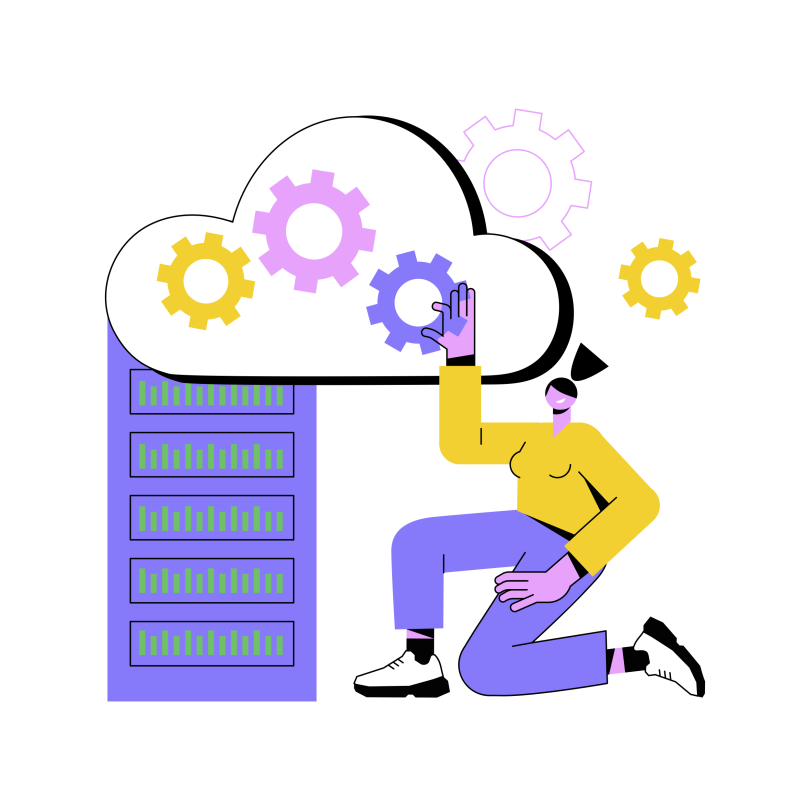More and more companies have heard the siren song of the cloud. With its low startup costs and ease of infrastructure setup, why wouldn’t they?
But the ability to ditch on-premises hardware in favor of the cloud — where someone somewhere else must attend to the maintenance and updating of the servers — still requires the experts who can make things run smoothly.
Enter cloud architects.
What Is a Cloud Architect?

What Exactly Is a Cloud Architect?
“When you think of an architect, you think of somebody who designs buildings and draws up plans for how to build them; a cloud architect does that in the cloud,” said Meg Yahl, cloud engineer at Uncomn, a business-to-business management and technology consulting services company.
To be more specific, a cloud architect helps a company develop, implement and maintain its cloud computing strategy. They need to have a keen understanding of their company’s needs, constraints, industry regulations and goals as it relates to cloud computing.
“Cloud architects are responsible for helping to design cloud architectures that may leverage more than one cloud platform and/or on-premises hardware, are resilient and scalable and, without question, are completely secure,” said Susanne Tedrick, a cloud infrastructure specialist at Microsoft cloud computing platform Azure and previously a technical specialist at IBM Cloud. Though not a cloud architect herself, Tedrick works closely with cloud architects in the course of helping clients with cloud adoption and migration.
“When you think of an architect, you think of somebody who designs buildings and draws up plans for how to build them; a cloud architect does that in the cloud.”
She added that the role of cloud architect requires very deep technical knowledge of cloud computing and complementary areas like computer networking, data and security.
Some titles frequently overlap with or are treated as interchangeable with cloud architects. These include cloud engineers and solutions architects in cloud-specific companies or departments. For example, though Yahl’s title is cloud engineer — with cloud engineers tending to be those who implement the designs and plans developed by a cloud architect — she regularly does both engineer- and architect-specific tasks.
Tedrick credited much of the title variations and overlap within the cloud architect role to its rapid evolution as cloud adoption has grown.
“Especially as there are subspecialties within the field, firms will often combine the architect roles with engineer or technician responsibilities,” she said.

Not Just Interacting With the Cloud
In general, a cloud architect’s day-to-day experience will revolve around identifying, meeting and implementing a company’s or client’s cloud needs, said Tedrick. This can mean leading technical deep-dive discussions, validating that a cloud solution will meet a company’s requirements or identifying potential workarounds, developing architecture diagrams and helping to develop proof of technologies and proof of concepts for clients. At times, it can also involve delivering general product and cloud computing education.
For Frank Dagenhardt — solutions architect for Zscaler, a cloud-based information security company — educating others about the cloud is a regular feature of his days. This can involve writing white papers and blog posts, or hosting industry user group webinars. And teaching efforts can be geared towards internal audiences like Zscaler’s staff, or externally to partners or customers.
“We work on enablement for our internal teams and our partners that we work with — making sure that they understand the solutions, know how they work, what types of different solutions we can help customers with and how they’re going to help customers,” he said.
Meeting with customers is also a major part of Dagenhardt’s days. He and his team discuss with customers what their needs are and how to best achieve them. These meetings often generate ideas for improvements to Zscaler’s products and services, either through customer requests or the team identifying common features that could serve the customers better.
“If there are feature gaps that we might have or things that customers are looking for that we don’t address today, we may go ahead and make those suggestions,” to their business unit, said Dagenhardt.
This shifting between communicating with customers and internal technical business teams requires cloud architects to have strong communication skills. Since a cloud architect works on the digital infrastructure that allows a company to function, they have the opportunity to interact with and lead technical discussions with diverse audiences like developers, network engineers, managers and more.
For Yahl, infrastructure work is what dominates her life lately. At Uncomn, she has learned quite a lot about networking infrastructure and how to deploy it. But a lot of what she’s doing recently has specifically involved a lot of infrastructure as code. This helps increase consistency across the company and reduce the opportunity for human error.
“You want to make sure that if you need to bring up another stack, another set of servers and all the things that go with it, you want to make sure you are doing it the same way every time,” she said.

Learning Is Part of the Everyday Routine
That need to learn new things and teach yourself new technologies is a common experience for cloud architects.
“The field is different every day,” said Yahl. “It’s one of those things where if you are not striving to learn, then you are falling behind.”
Dagenhardt said the fast pace of advancement in cloud technologies is one of the things that keeps him up at night. He pointed out that AWS expanded its offering to over 200 services in September. And that was just one vendor.
Staying up to date with the options, how customers might leverage new technologies and the best practices that might go into keeping them secure all require constant learning. For Dagenhardt, keeping up on certifications and learning new things makes him feel at the top of his game.
“That’s always been something that has helped me out — dedicating some of my time for personal advancement and improvement,” he said.
Yahl also spoke about the importance of continuing your education and certifications, but she also stressed the value of learning from the people you work with.
“It’s one of those things where if you are not striving to learn, then you are falling behind.”
“You learn from each other, especially shortcuts or tools to make life easier,” she said, giving Visual Studio Code and ShellCheck as examples of resources she’s learned from coworkers.
But she said it’s more than just picking up handy tools that can make the day easier. There’s also the collaborative element of getting to see different perspectives on how to use or implement different technologies.
“When you’re working by yourself, you’re in a vacuum and you’ve got nobody to view your code, nobody to make sure you’re sticking to best practices as best you can or know about new and evolving ways of doing things,” Yahl said.
In those situations where a cloud architect might not have coworkers to learn from, Yahl suggested places like Reddit where others in the tech community go to ask questions of one another about the best resources for different situations.
“You basically have a list of stuff that people will recommend and then you get other people’s views on the good and bad about those tools and there’s a conversation that goes back and forth,” she said. “So even if you don’t have the coworkers to guide you, you’re still able to see those multiple viewpoints.”

Security Concerns in a Fast-Growing, Multi-Cloud Field
Understanding and being able to work in more than one platform is a growing necessity for cloud architects. Dagenhardt advised would-be cloud architects to have a mix of perspectives when it comes to cloud platforms because that’s where he sees the future of the field going.
“What we’ve seen in the cloud industry is that, while most customers start off in a single cloud vendor, over time they become a multi-cloud environment where they do host some of their resources in one or more clouds,” he said. He also said that he is seeing a growing shift from infrastructure as a service to containers or even serverless technologies.
According to Tedrick, this trend towards cloud diversification, other cloud-based strategies and factors such as the “larger cloud computing battle between AWS, Google and Microsoft,” will keep the cloud architect role in vogue. This means employers looking for cloud architects will want to know what cloud platforms architects have hands-on experience with.
“We’re going to have a reckoning in the security world, that’s for sure.”
Security in this expanding, nebulous environment is and will continue to be a concern for people who work with the cloud.
“We’re going to have a reckoning in the security world, that’s for sure,” Yahl said. “There are so many people who want to get into the field and they learn their basics, but they don’t learn the security behind it.”
This is in part due to the speed of the cloud field outpacing the ability of most formal education to keep up-to-date with security training, but also because the cloud has, according to Yahl, “the lowest barrier to entry for anybody who needs to set up their infrastructure.”
“The cloud is great for spinning up servers and infrastructure and all of that really, really quickly and really easily,” she said, adding that a lot of the defaults within the cloud environment can be insecure. “Cloud is a way to get up and running really fast but you have to secure it as well.”
The speed of cloud technologies’ advancement also has Dagenhardt asking security questions about the future.
“We still have older and more legacy technology that we have to be able to handle as well and accommodate,” he said. “How do we protect the traditional environment as well as protect the cloud environment, and make sure that it’s manageable and not creating double the work for the customers?”

How to Become a Cloud Architect
If constantly learning and adapting to the shifting needs of customers and the evolving cloud landscape sounds appealing, there are some pieces of advice to keep in mind. Top among those is that cloud architects must know and understand cloud computing well beyond the basics, said Tedrick.
“They’ll need to understand best practices around enterprise cloud security, governance, cost optimization, hybrid cloud architecture — using an on-prem and cloud environment — and multi-cloud architecture — using two or more clouds,” she said. “Hands-on experience on a cloud platform where they are creating and monitoring resources is a must, with a year or more of experience preferred.”
For those who don’t have the opportunity for on-the-job cloud work, Tedrick recommended online lesson platforms like A Cloud Guru and Pluralsight that give users hands-on experiences with different cloud platforms.
When it comes to applying for a cloud architect role, Yahl said job seekers should not get discouraged if a posting includes requirements you don’t have or involves tasks you’re not familiar with. She also pointed out that job postings are sometimes not written by technical experts and ask for the impossible. This might be something like asking for more years of experience in a product than it has existed.
“If you’re looking to get into the field, don’t let one thing scare you off of a position that you have most of the skills for,” she advised.
Yahl also encouraged those looking to get into the field of cloud architecture to show off their skills and the fact they have grown and changed over the years. She pointed to Github or other platforms where users can host code as great places to create a coding portfolio.
Certifications are important for potential cloud architects. These can be either vendor-specific and vendor-agnostic. The more general certifications can be helpful for general information and cloud best practices, but, according to Dagenhardt, vendor-specific certifications are often more useful since they will deal with specific cloud products and their best practices.
Tedrick also pointed out that certifications for the major vendors — Microsoft, AWS, Google and IBM — are more likely to be recognized by potential employers.
But she stressed that “the goal should be gaining skills and experience versus acquiring certifications, as the certification will only get you so far, and great architects are born out of trial, error and time.”

